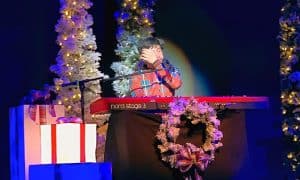Gays cheered at Brigham Young University — millennial Mormons are increasingly tolerant of same-sex attraction.
During a recent valedictorian graduation speech, student Matthew Easton came out saying he is “a gay son of God.” His admission was met with loud applause from the audience.
What makes this unusual is that Easton is a student at Brigham Young University, the flagship educational institution of the Church of Jesus Christ of Latter-day Saints, which forbids any form of same-sex intimacy.
What does this coming out as gay mean for the church and modern-day Mormonism?
Coming out at BYU
In recent times, coming out at BYU has been increasingly accepted, if not always cheered.
Charlie Bird, who wore BYU’s cougar mascot costume “Cosmo” from 2015 to 2018 and became the face of Brigham Young University, came out just a few months ago.
Last year one of BYU’s official Instagram accounts was turned over to student Kyle Manwaring for one day, who talked about what it was like to be gay at BYU.
A student group at BYU, “Understanding Sexuality, Gender and Allyship,” has become a resource for many LGBTQ students there.
Related | LoveLoud Festival Challenges Mormon Church on LGBT Rights
As a scholar of Mormonism and sexuality, I would argue that what made this possible was a change in the honor code in 2007.
The honor code at BYU since 2007 explicitly states: “Brigham Young University will respond to homosexual behavior rather than to feelings or attraction and welcomes as full members of the university community all whose behavior meets university standards….One’s stated same-gender attraction is not an honor code issue.”
While still prohibiting homosexual “behavior,” this revised code is accepting of same-sex attraction.
Under this code, students could take on LGBTQ identities but not kiss, date or show other forms of physical intimacy that are allowed for straight members.
‘Don’t say gay’ policy
That the church has become accepting of LGBTQ labels needs to be seen in its historical context to understand how big a change this is from a previous era.
Historian Gregory Prince writes in his book “Gay Rights and the Mormon Church” that starting in the 1960s, LDS church leaders believed that homosexuality could be “cured” and that it had certain social and psychological causes.
By the 1970s, the gay rights movement was gaining a lot of ground nationally, and LDS leaders were afraid of its impact on the Mormon community.
Around this time, LDS church leaders came to believe that the use of the terms “gay,” “lesbian” and “homosexual” could contribute to same-sex sexual attractions. A 1981 church handbook advising local church leaders on how to counsel with young people advised: “Be careful not to label people ‘homosexual.’ This both discourages them and tends to make them feel that they cannot solve their problems.”
These ideas held sway for a long time. In 1995, church leaders began to regularly speak in terms of a psychological condition that they called “same-gender attraction.” That was their alternative to the sociopolitical labels of “gay” and “lesbian.”

Change and resistance
Along with the BYU honor code change in 2007 came a better acceptance of Latter-day Saints identifying as gay, lesbian and queer. In fact, the church too uses these labels actively.
An official church website organized in 2012, MormonsandGays.org, and its update in 2016 MormonandGay.lds.org prominently featured Latter-day Saints who adopted these identities.
Not all church leaders, however, have welcomed these changes. In 2009, high-ranking church leader Bruce Hafen warned that “you feed the angry dog” of same-sex attraction when you “label yourself as gay.”
And in 2014, another top church leader, David A. Bednar, responded to a question about how to welcome homosexuals in the church, saying: “there are no homosexual members of the church.”
Mormon millennials and change
Even though same-sex erotic behavior is still forbidden at BYU, I argue that the cultural and policy shifts that allow for identifying as LGBTQ at BYU are important signals of larger shifts in Mormonism.
Scholar Jana Reiss’ new book “The Next Mormons” documents that more than half of Mormon millennials support same-sex marriage.
A recent protest against the Brigham Young honor code has also called for changes to the way it treats LGBTQ students.
Indeed, LGBTQ BYU students still report alienation, loneliness and judgment. But, at the same time, the cheers for Matthew Easton’s graduation speech show that a significant change is happening.
Taylor Petrey is an Associate Professor of Religion at Kalamazoo College
This article is republished from The Conversation under a Creative Commons license. Read the original article.







